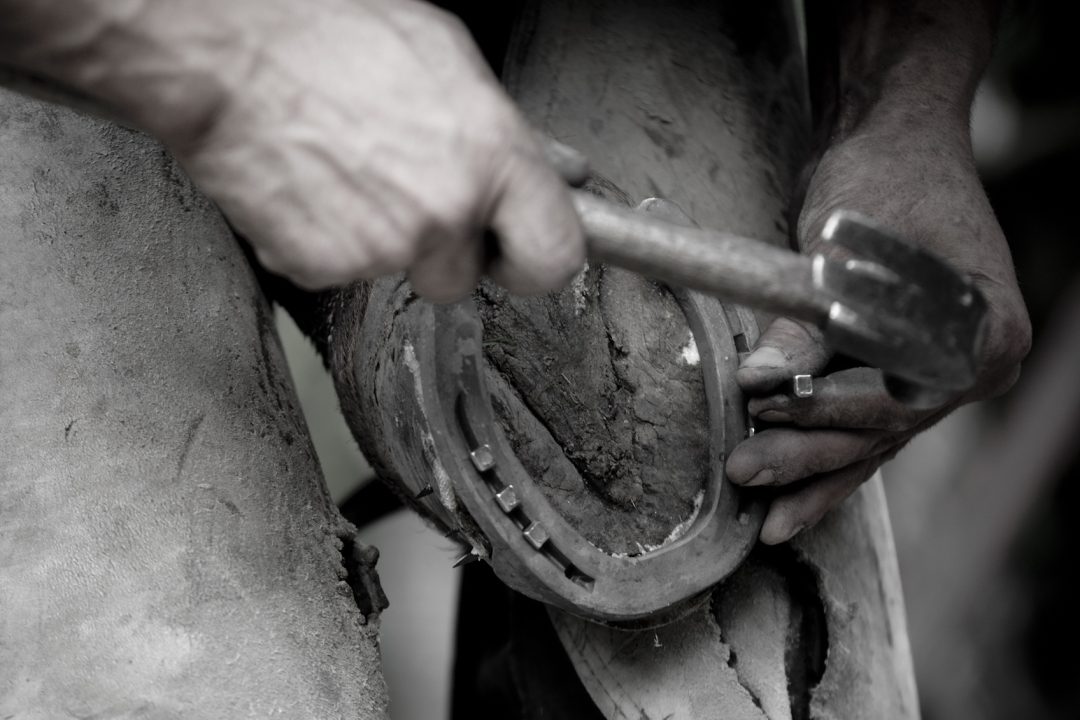First I need to preface my remarks by saying; I am a farrier, as well as a natural footcare practitioner.
The Natural hoof care movement started in the early eighties and has been gaining in popularity.
They have several compelling arguments that I must acknowledge, such as; driving nails into the foot, isn’t good for the hoof capsule. And that steel shoes retard expansion of the hoof capsule (see note below). The barefoot movement has contributed greatly to the soundness and well being of the horse with their holistic approach. I have benefitted from the research of wild horses. I use hoof mapping techniques garnered from Duckett’s Dot, Gene Ovnicek’s E.D.S.S. system, and Pete Ramey’s method, to determine the hoof’s ideal confirmation and size in my practice daily.

Originally natural hoof care advocates posited that every horse given enough time would be able to adjust to being barefoot, while being able to do its job. That premise did not always make it in the real world.
When natural hoof care was in its early stages, I knew one natural hoof care practitioner that had a thoroughbred horse go barefoot in a paddock for a year, even though it was lame. The natural hoof care practitioner insisted that the horses feet given enough time, would callous up and be serviceable. The thoroughbred due to his thin soles and soft feet never calloused up. The owner after a year of paying for feeding and boarding an unusable horse, finally gave up and had the horse shod. Once the horse was shod, the horse was serviceable in a week.
The main reason going barefoot with the thoroughbred didn’t work was genetics. Barefooters base their theories of optimal hoof conformation and function from feral horses. Brumbies and mustangs are not thoroughbreds. If a brumby had thin weak feet like a thoroughbred, natural selection would ensure the culling of the horse by predators. For this reason said horse would not able be breed and pass this genetic weakness on. Although it is not natural for horses to wear shoes in the wild, it is also not natural for a horse to be a thoroughbred.
It’s hard to compare feral horses, to horses that have been bred for specific purposes; such as, quarter horses that compete in gymkhana classes, or thoroughbreds that were bred for racing on a track.
Our breeding and domestication of the horse has given us some bad dividends such as abnormal conformation, diseased, and weak hoofs. Domestic horses have challenges/obligations that feral horses do not. A feral horse is not required to gallop with a two hundred pound rider on a paved road. My example is extreme, but you get the picture.
Natural footcare have had to acknowledge over time that not every horse can so its job without some form of protection.
So natural footcare have gone to boots, and various other modalities to protect the horse’s feet for work and competition.
Boots, glue on shoes, etc., have their problems and limitations too:
- Boots are a great option, but they cannot address every situation.
- Boots, glue on’s (and their variants) trap moisture and bacteria.
- If boots aren’t fit properly, they cause rubs and irritations.
- Boots cannot remediate all hoof capsule imbalances like remedial shoeing can.
- If your horse has abnormal feet such as a club foot, it can be difficult to keep the boot on the horses, foot.
Boots have to be put on, and taken off regularly for what would be considered the normal activity of the shod horse, such as turnouts. The application and removal of boots for certain activities have some horse owners feeling that this as an added inconvenience. Especially when they have bad backs and high strung horses.
Many horse owners/riders do not have enough resources (in certain areas land can be very expensive) to live up to ideals of the barefoot movement. So unfortunately, many horse owners are forced to work within their constraints. These horse owners if they could, would turn their horses out on large acreage with natural grass, water, and other horses. Many horse owners do not have those resources so; they board their horse at a stable, turn the horse out in a paddock, and ride the horse as much as they can.
These horse owners are the ones that find it practical to use farrier services.
I don’t think it is helpful to say (as some natural hoof care advocates have said) that farriers are damaging feet, and decreasing the serviceable life of the horse. That I feel is provocative, and painting with a broad brush.
In response to that, I would like to point out that farriers like Jamie Jackson and Gene Ovnicek pioneered the natural hoof care movement. While not every farrier is qualified to be in practice, the same can be said for natural hoof care practitioners.
Experienced and gifted farriers working alongside Veterinarians have saved many equids from suffering and death (such as in founder cases). The farriers’ goal should be, to facilitate the well being, service and longevity of the horse. Experienced and qualified farriers have facilitated the well being and longevity of many equids. I’m happy to say, I have many senior horses at high activity levels; who have worn traditional shoes all their lives, and are still enjoying their lives of work and play.
The best way to determine whether your horse can go barefoot or not; is to consult with a footcare professional to go over your particular situation and needs.
Note: Steel shoes limit the expansion of the hoof capsule. Limiting the expansion of the hoof capsule is beneficial in instances of fractured coffin bones, quarter crack repairs, and hoof wall avulsions. Egg bar shoes are still a great tool for treating sheared heels.
